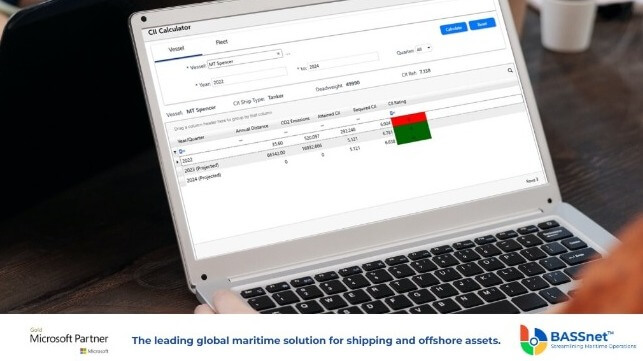CII is an Opportunity for Shipping to Gain a Competitive Advantage

From January 1, 2023, the IMO’s new Carbon Intensity Calculator (CII) Regulation requires all ships over 5,000 gross tonnage to calculate and report their carbon emissions. The aim is to reduce shipping’s carbon footprint.
BASS Software has over 25 years’ experience developing best-in-class maritime ERP software. The company’s end-to-end BASSnet software suite enables easy and effective environmental management inclusive of user-friendly carbon calculators.
Here’s what BASSnet experts have to say on the CII regulation’s impact for shipping:
CII Regulation and the Benefits of Digital Environmental Management
 [By Rajesh Purkar VP, Product Management (Marine Operations), BASS Software]
[By Rajesh Purkar VP, Product Management (Marine Operations), BASS Software]
The new CII regulation is the next step forward to drive sustainability. I fully understand the challenges faced by ship owners and managers in meeting compliance requirements. However, the CII regulation also provides an opportunity to benefit beyond the environmental impact.
For one, reducing carbon emissions can lead to cost savings. Fuel accounts for a significant portion of a shipping company's expenses. Energy efficiency can translate into lower costs. Secondly, investing in new technologies and innovations that reduce emissions can prove cost-effective.
Of course, CII compliance is just one aspect of sustainable shipping. Companies must also adhere to many other regulations and standards, such as the International Convention for the Prevention of Pollution from Ships (MARPOL), the Ballast Water Management Convention, IHM, EU MRV, and IMO DCS requirements.
Again, the challenges are there. However, shipping companies can and must leverage the power and scalability of digital environmental solutions for greater efficiency and cost savings.
BASS is proud to be a leader in developing innovative maritime ERP software for sustainable shipping. The integrated BASSnet Fleet Management System enables paperless vessel management. Our comprehensive Environmental Management solutions are designed to meet regulatory reporting requirements for EU MRV, IMO DCS, IHM and CII compliance.
Our brand new Carbon Intensity Indicator (CII) Calculator is an example of innovation at its best.
Effective CII Monitoring Using Carbon Calculators
Using the right carbon calculator can bring value on a fleet-wide scale. As part of our enhanced BASSnet 2.11 Service Pack 2 release, we launched an innovative CII Calculator to enable ship owners and managers easily evaluate vessel CII rankings and take necessary steps to comply with the CII regulation.
You can use our CII Calculator to effectively:
- Calculate vessels attained CII and corresponding rating (A to E) based on IMO resolutions MEPC.352(78), MEPC.353(78) & MEPC.354(78).
- Visualize and monitor CII rating on a fleet and vessel level.
- Derive calculations directly from data within the electronic BASSnet Ship Log.
- View and calculate future projections of CII rating.
- Export CII Calculations into protected external format.
CII Calculators, especially those integrated into an end-to-end system like BASSnet, are a great example of how digitalization can bring benefits when executing environmental initiatives. Let's seize the opportunity afforded by the CII regulation for a more energy efficient future.
Embracing CII Compliance for Environmental & Business Benefits
 [By Johannes Hapke, Business Analyst Manager, BASS Software]
[By Johannes Hapke, Business Analyst Manager, BASS Software]
The CII regulation is a positive and yet very challenging step towards more sustainable shipping practices. It is an important milestone to meet the EU’s ’Fit for 55’ requirements and ultimately for achieving climate neutrality by 2050. Pressure has now been put on ship owners, managers and charterers to comply with the newly introduced carbon emission regulations and emission profiles.
Contrary to the EEXI (Energy Efficiency Existing Ship Index), CII is a dynamic rating that takes ship operations into account. Fully loaded vessels that transport cargo over long distances have a better chance to achieve a desirable CII rating.
However, certain vessel types such as feeder ships or steam-powered LNG vessels–which still account for a substantial part of the LNG fleet–will face more challenges to achieve a positive rating due to their nature of business if no correction factors are applied in future.
Hence, it is more crucial than ever to accurately monitor vessel emissions and to have tools on hand to calculate and forecast emissions and CII ratings for single vessels and entire fleets.
I would also like to emphasize the importance of business intelligence. Simply tracking emissions is not enough. Companies gain most value out of the data collected if BI solutions are used to visualize data in multi-dimensional ways.
Using the BASSnet Business Intelligence (BI) Dashboard, for example, ship owners and managers can view and track environmental KPIs to optimize their decision making for greater productivity and cost efficiency on a fleet-wide level.
This is also why it can be critical to use end-to-end maritime ERP software with integrated carbon calculators (such as the BASSnet CII Calculator) for fleet-wide insights.
Despite the challenges, the CII regulation presents an opportunity for ship owners and managers to take proactive steps that bring a business advantage, provided they are equipped with the right tools.
Smooth Sailing to a Sustainable Future
The CII regulation is an important initiative to create a more sustainable future. By embracing the regulation, shipping companies can make a real impact in the fight against climate change while gaining business benefits.

that matters most
Get the latest maritime news delivered to your inbox daily.
Using the right environmental management software and carbon calculators can be essential to save costs and stay competitive.
Learn more about BASS’s comprehensive environmental management solutions and CII Calculator today
The opinions expressed herein are the author's and not necessarily those of The Maritime Executive.
